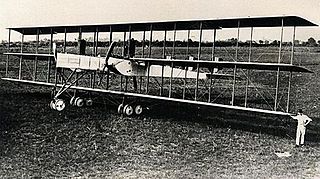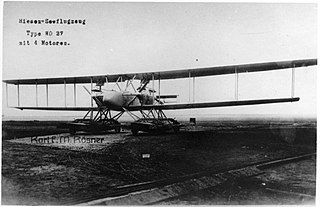
The Douglas Y1B-7 was a 1930s American bomber aircraft. It was the first US monoplane given the B- 'bomber' designation. The monoplane was more practical and less expensive than the biplane, and the United States Army Air Corps chose to experiment with monoplanes for this reason. At the time the XB-7 was ordered, it was being tested by Douglas Aircraft as an observational plane.

The Caproni Ca.4 was an Italian heavy bomber of the World War I era.

The Fokker Eindecker fighters were a series of German World War I monoplane single-seat fighter aircraft designed by Dutch engineer Anthony Fokker. Developed in April 1915, the first Eindecker ("Monoplane") was the first purpose-built German fighter aircraft and the first aircraft to be fitted with a synchronization gear, enabling the pilot to fire a machine gun through the arc of the propeller without striking the blades. The Eindecker gave the German Army's Air Service (then the Fliegertruppen des deutschen Kaiserreiches) a degree of air superiority from July 1915 until early 1916. This period, during which Allied aviators regarded their poorly armed aircraft as "Fokker Fodder", became known as the "Fokker Scourge".

The Fokker E.I was the first fighter aircraft to enter service with the Fliegertruppe of the Deutsches Heer in World War I. Its arrival at the front in mid-1915 marked the start of a period known as the "Fokker Scourge" during which the E.I and its successors achieved a measure of air superiority over the Western Front.

The Fokker M.5 was an unarmed single-seat monoplane aircraft designed and built by Anthony Fokker in 1913. It served as a light reconnaissance aircraft with the German army at the outbreak of World War I and was the basis for the first successful fighter aircraft in German service, the Fokker E.I.

The Vickers F.B.5 was a British two-seat pusher military biplane of the First World War. Armed with a single .303 in (7.7 mm) Lewis gun operated by the observer in the front of the nacelle, it was the first aircraft purpose-built for air-to-air combat to see service, making it the world's first operational fighter aircraft.

The Fokker D.I was a development of the D.II fighter. The D.I was also flown in Austro-Hungarian service as a fighter trainer aircraft under the designation B.III. Confusing the matter further, both the D.II and D.I arrived at the Front in German service at similar times, in July–August 1916. The main designer was Martin Kreutzer.

The PZL.38 Wilk (wolf) (PZL-38) was a Polish heavy fighter developed and manufactured by PZL state factory in 1937. Intended for use primarily as a fighter-bomber, the Polish Air Force also envisioned it replacing light fighters in long-range operations, along with being able to serve as a light bomber. Only two examples were built before the project was cancelled in favor of a planned improved variant, the PZL.48 Lampart.
The PZL.48 Lampart (leopard) was a Polish heavy fighter-bomber design, that remained only a project, owing to the outbreak of World War II.

The Friedrichshafen G.I was a prototype heavy bomber aircraft that was built in Germany by Flugzeugbau Friedrichshafen in 1915. It was Karl Gehlen's first design for the company, and although it was not produced in quantity, it provided the foundation for the later, highly successful bombers culminating in the G.III.

The Savoia-Marchetti SM.91 was a two-seat, twin-engined, Italian heavy fighter prototype, designed to compete in a 1942 revision to a long-range fighter-bomber contract offered by the Regia Aeronautica to Italian aircraft companies in 1938. The original 1938 specification yielded the Savoia-Marchetti SM.88, which the SM.91 was largely based on.

The SPAD S.A was a French two-seat tractor biplane first flown in 1915. It was used by France and Russia in the early stages of the First World War in the fighter and reconnaissance roles. It was a unique aircraft that carried its observer in a nacelle ahead of wing, engine and propeller.

The Gotha WD.27 was a long-range maritime patrol floatplane developed during World War I by Gothaer Waggonfabrik (Gotha) for the Imperial German Navy's Naval Air Service. It was a large, four-engine aircraft with the same general layout as the WD.22; a conventional floatplane with engines grouped in tractor-pusher pairs on the lower wings. Three aircraft were ordered in early 1918, but the first prototype was not completed until after the end of the war in November. It may not have flown before it was ordered to be destroyed by the victorious Allies.

The Junkers CL.I was a ground-attack aircraft developed in Germany during World War I. Its construction was undertaken by Junkers under the designation J 8 as proof of Hugo Junkers' belief in the monoplane, after his firm had been required by the Idflieg to submit a biplane as its entry in a competition to select a ground-attack aircraft.
The Armstrong Whitworth F.K.5 and F.K.6 were experimental triplanes built as escort fighters by Armstrong Whitworth during the First World War. They carried two gunners in nacelles mounted on the centre wing. One example of each type was built, with no further development or production following.

The Albatros C.II was a 1916 German military pusher biplane designed and built by Albatros Flugzeugwerke. Only one prototype was built and the type did not enter production.

The Zeppelin-Staaken Riesenflugzeuge were a series of very large bomber aircraft - Riesenflugzeuge, usually powered by four or more engines, designed and built in Germany from 1915 to 1919.

The Zeppelin-Lindau Rs.III was a large four-engined monoplane flying boat designed by Claudius Dornier and built during 1917 on the German side of Lake Constance at the Zeppelin-Lindau works.

The Daimler G.I, originally designated Daimler R.I, was a bomber aircraft designed and built in Germany from early in 1915.
The Kondor E 3, sometimes erroneously known as E.III, was a German single seat, monoplane fighter aircraft designed and built close to the end of World War I. Though successful in the third D-type fighter competition at Aldershof in September 1918, only a few were produced, given the Idflieg designation of Kondor D.I.

















